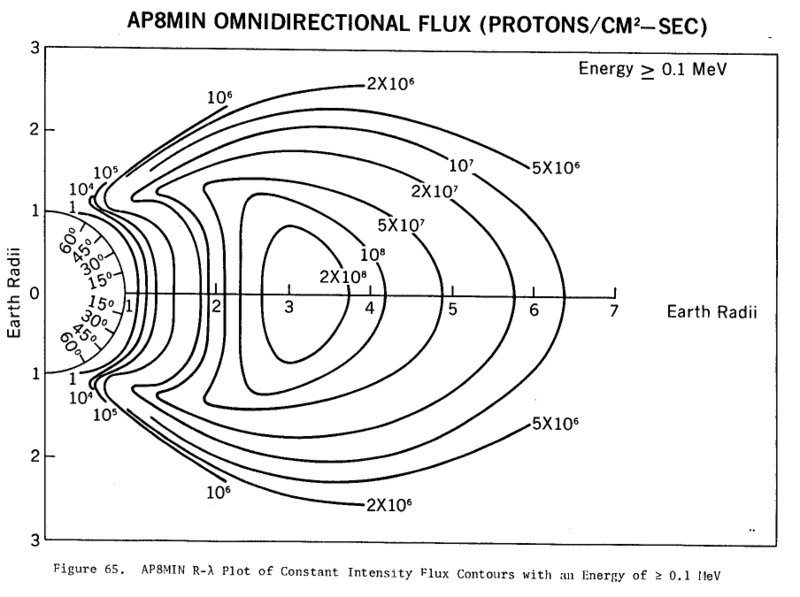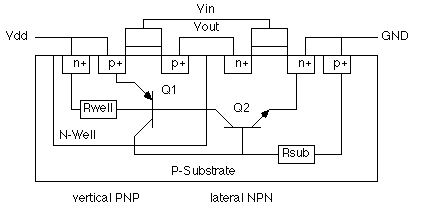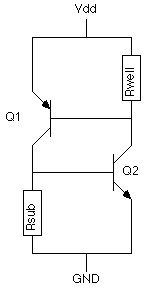|
Size: 7992
Comment:
|
Size: 8830
Comment:
|
| Deletions are marked like this. | Additions are marked like this. |
| Line 3: | Line 3: |
| === The inner and outer van Allen belts === | == The inner and outer van Allen belts == |
| Line 5: | Line 5: |
| {{attachment:belts.jpg}} The M288 orbit ( 4 hour sidereal, 5 orbits per day relative to the earth) is located at a radius of 12789 km, about 6400 kilometers altitude. That places it between the inner and outer van Allen belts. This is a relatively high radiation environment compared to low earth orbit, but lower than the center of the belts. Recent advances in semiconductor technology permit unshielded electronics to operate in this region, and Server Sky takes advantage of that work. Traditional satellites are damaged by this much radiation; consequently, there are few satellites operating in these orbits. |
|
| Line 6: | Line 14: |
| MORE LATER | == Ionizing radiation and semiconductor damage == |
| Line 8: | Line 16: |
| === Ionizing radiation and semiconductor damage === | Ionizing radiation does five nasty things to semiconductors: * Latchup * SEU - single event upsets, bit flipping * Oxide charging * Flash memory errors * Crystal lattice degradation Server sky is designed to resist these effects. The space radiation environment is well characterized and computer models exist, such as [[http://www.kirtland.af.mil/library/factsheets/factsheet.asp?id=7899 | AF-GEOSPACE ]]. The radiation effects can also be empirically tested in ground laboratories, at high dose rates, and extrapolated to the effects of years of space radiation exposure. === Latchup === || {{attachment:latchup1.gif}} || {{attachment:latchup2.gif}} || The NMOS and PMOS transistors in a CMOS integrated circuit are often isolated from each other by diode junctions. The first drawing above shows a PFET in an N well next to an NFET in a P well. A P source, N well, P well, and N source make a PNPN junction stack, as shown in the second drawing. This is much like a device called a Silicon Controlled Rectifier or SCR, which is a commonly used latching electrical switch. When the currents are high enough in an SCR, a positive feedback loop is established, latching the device in a conductive state. In this case, that can form a high current conducting path between the power supply and ground. This heats up the silicon, and can destroy it. An ionizing radiation particle can create a temporary high current path that can activate an SCR and cause latchup. This is a problem in electronics exposed to radiation. It is usually mitigated by special design for latchup resistance, and heavy shielding for the electronics. Server Sky cannot afford the shielding weight, or the special design. The SCR path cannot be activated if the voltage between the supply and ground is less than a diode turn-on voltage (typically more than 0.7V). The electronics in a Server-Sat are powered by a single-junction solar cell, which is a large forward-biased silicon diode. It cannot produce more than about 0.6V. '''A server-sat cannot latch up''' In some special circumstances, circuits called "voltage multipliers" may be used to construct higher voltages for special needs. However, the voltage multipliers will be low current and easily switched off, so damaging high current latchup will not be possible in these circuits, either. === Single Event Upsets === The charge deposited by an ionizing particle can temporarily overwhelm a logic gate, or change the state of a register bit. This can cause incorrect computations. Often the cost of such an error is small, for example when computing the I and Q signal of a software defined radio - a calculation error will just create a little extra noise. The cost is unacceptable when determining CPU state, performing calculations, and such. While computation errors can be detected and corrected with redundancy, either by duplicating hardware or by repeating calculations, redundancy is lowers performance and computational efficiency. One promising approach is to use the [[ cag-www.lcs.mit.edu/~cbatten/isscc2008/22.1_blaauw_razor2_isscc2008.pdf | RAZOR error correction technology]] being developed by the University of Michigan, MIT, and Intel. Digital integrated circuits are typically designed for high "noise margin", with extra power and voltage swing added, and clock rates reduced, to reduce the chances of a logic failure to infinitesimal probabilities. However, this is costly and reduces performance. RAZOR greatly reduces the noise margin, greatly improving the performance, but at the cost of frequent errors. RAZOR adds circuitry to detect these errors, and repeat the calculations when they occur. The system can be tuned so that the performance improvement greatly exceeds the cost of the extra calculations, almost doubling overall performance. RAZOR technology will be common in logic chips and processors in a few years. Radiation-initiated single event upsets are just another kind of error, which can be detected and corrected by RAZOR-like technology. Since these SEU events may occur in the error correction logic itself, there will need to be additional redundant logic in the correction circuitry, but that will still be a net win over adding redundancy to the entire chip. === Oxide Charging === |
| Line 15: | Line 53: |
| Line 17: | Line 54: |
| === Flash Memory Errors === | |
| Line 18: | Line 56: |
| === Space Junk and Debris === | Error correcting memory - MORE LATER === Crystal Lattice Damage === Annealing - MORE LATER ------ == Space Junk and Debris == |
| Line 22: | Line 67: |
| Most of the relevant debris will be associated with geosynchronous transfer orbits. Upper stage boosters will be in inclined orbits from higher latitude launch sites (28 degrees [[http://en.wikipedia.org/wiki/Kennedy_Space_Center|KSC]], 46 degrees [[http://en.wikipedia.org/wiki/Baikonur_Cosmodrome|Baikonur]], 20 degrees [[http://en.wikipedia.org/wiki/Wenchang_Satellite_Launch_Center|Wenchang]]), and 5 degrees ([[http://en.wikipedia.org/wiki/Guiana_Space_Centre|Kourou]]). [[http://en.wikipedia.org/wiki/Molniya_orbit|Molniya]] orbits are lower, bit are less common. Until they decay, none of these inclined geosynchronous transfer orbits (GTO) pass through the equatorial plane at m288 altitudes. |
{{attachment:V900H13_earth_to_geoDBS.png | HV plot of potential colliders up to GEO }} |
| Line 25: | Line 69: |
| {{attachment:collision.png}} | The above plot shows all the objects tracked by NORAD in orbits up to geosyncronous altitude. This is an "HV" plot, with the horizontal H component representing the radius in the equatorial plane, and the vertical V component representing the distance above the plane. All orbits will look like an ellipse or banana shape plotted in this way. Red is debris, darker red is spent rocket bodies, and green is useful satellites. |
| Line 27: | Line 72: |
| Even for debris with apogees that cross the equatorial plane at m288, the area of that plane crossing is vast, 75 million square kilometers for a server sky region 1000km across. A given debris particle intercepts on the order of square meters or square centimeters per pass, and crosses through only once every 2.3 hours. If its orbit decays in 5 years, it will make less than a thousand passes before its apogee falls below m288. For example, a 10m2 booster stage, passing through 1000 times, the chance that it will hit any particular server sat (without avoidance) is on the order of 100 parts per billion. Booster stages are easy to track by radar, so they will almost surely be avoided by maneuvering the server-sats out of their path. Smaller debris will be more numerous, and have higher surface-to-mass ratios, so those particles will decay faster. While any given debris particle may have a very small total intercept area through the m288 zone, there may be tens of thousands, and they will be harder to track, so this probably represents a larger problem. | Th |
| Line 29: | Line 74: |
| Note that very small particles will punch a hole through the server-sat, but probably won't shatter it. This may disable some portion of the server-sat (probably a segment of solar cell), but with a little power switching the server-sat will still be maneuverable and capable of reduced activity. | {{attachment:V900H13_earth_to_geoxxS.png | HV plot of assets up to GEO }} |
| Line 31: | Line 76: |
| Here are some plots from a paper simulating debris-created collisions in 1994, with the server-sky orbits shown as a pink circle. This is only indicative, since highly eccentric orbits cut across many radii, but it does illustrate that most space debris is associated with the orbits of the colliding bodies that produced it, and most of these bodies are in highly inclined orbits or low earth orbits, never coming near the equatorial m288 orbit with inclinations limited to 2.4 degrees, eccentricities of 0.04, and a semimajor axis of 12789 km. | {{attachment:V900H13_earth_to_m288DBS.png | HV plot of potential colliders up to m288 }} |
| Line 33: | Line 78: |
| {{attachment:SS_a_e.gif}} {{attachment:SS_a_i.gif}} |
{{attachment:V900H13_earth_to_m288xxS.png | HV plot of assets up to m288 }} |
| Line 36: | Line 80: |
| {{{#!wiki caution '''Volunteer Opportunities''' |
{{attachment:V900H13_m288DBS.png | HV plot of potential colliders intersecting m288 }} |
| Line 39: | Line 82: |
| Compute the actual flux of particles that intercept the server-sky orbit. | {{attachment:V900H13_m288xxS.png | HV plot of assets intersecting m288 }} |
| Line 41: | Line 84: |
| Compute the actual orbital elements of spent booster stages in decaying geosynchronous transfer orbits from various launch centers. }}} Some small fraction of this orbiting debris may have perigees low enough to suffer appreciable drag in the extreme upper atmosphere. This will have the effect of lowering their apogees down into the server-sky orbit, to potentially collide with server sats. A problem with such decaying orbits is that their orbital elements become somewhat unpredictable - the apogee location will depend on the orientation and drag of the debris as it passes through the atmosphere, so it will be difficult to predict more than half an orbit in advance. However, there will still be perhaps an hour of tracking time between the most recent perigee and the passage through m288, and at 1 micron per second squared acceleration (5 percent of maximum), that is enough time for a server sat to move 2 or 3 meters out of the way of a precisely predicted orbital track. The key point here is precise prediction - to reduce the chances of a collision to zero, the radar systems will need to be very good. The loss of one server sat through a collision is not a big problem in itself - there are plenty more where that came from. The biggest risk is the debris resulting from the collision, which will tend to be in the same orbits as the rest of the server-sats, and may pose a long-term collision hazard for those. The effect of solar wind on these uncontrolled bits of secondary collision debris is unknown. In the long run, it will be better to remove space debris before it collides with the server sats. The server-sats are travelling faster than the debris they are likely to encounter, so any collisions between them and debris at apogee will most likely increase the orbital energy, raise the perigee, and lengthen the decay time of the debris. To remove debris (lower it's perigee into thick atmosphere) it must lose apogee velocity, either by colliding with material in a suborbital ballistic, material with an opposite inclination, or with material in a retrograde orbit. The important thing is to make sure that the small particulate debris from such collisions is captured. This is an unsolved problem. |
|
| Line 58: | Line 91: |
| === Ionizing radiation, charge upsets and latchup === MORE LATER |
The Space Environment
The inner and outer van Allen belts
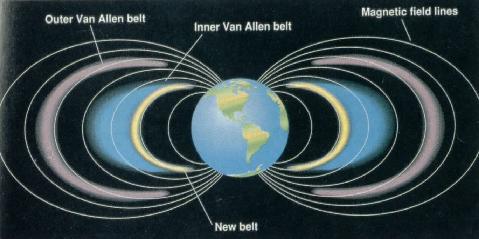 The M288 orbit ( 4 hour sidereal, 5 orbits per day relative to the earth) is located at a radius of 12789 km, about 6400 kilometers altitude. That places it between the inner and outer van Allen belts. This is a relatively high radiation environment compared to low earth orbit, but lower than the center of the belts. Recent advances in semiconductor technology permit unshielded electronics to operate in this region, and Server Sky takes advantage of that work. Traditional satellites are damaged by this much radiation; consequently, there are few satellites operating in these orbits.
The M288 orbit ( 4 hour sidereal, 5 orbits per day relative to the earth) is located at a radius of 12789 km, about 6400 kilometers altitude. That places it between the inner and outer van Allen belts. This is a relatively high radiation environment compared to low earth orbit, but lower than the center of the belts. Recent advances in semiconductor technology permit unshielded electronics to operate in this region, and Server Sky takes advantage of that work. Traditional satellites are damaged by this much radiation; consequently, there are few satellites operating in these orbits.
Ionizing radiation and semiconductor damage
Ionizing radiation does five nasty things to semiconductors:
- Latchup
- SEU - single event upsets, bit flipping
- Oxide charging
- Flash memory errors
- Crystal lattice degradation
Server sky is designed to resist these effects. The space radiation environment is well characterized and computer models exist, such as AF-GEOSPACE. The radiation effects can also be empirically tested in ground laboratories, at high dose rates, and extrapolated to the effects of years of space radiation exposure.
Latchup
|
|
The NMOS and PMOS transistors in a CMOS integrated circuit are often isolated from each other by diode junctions. The first drawing above shows a PFET in an N well next to an NFET in a P well. A P source, N well, P well, and N source make a PNPN junction stack, as shown in the second drawing. This is much like a device called a Silicon Controlled Rectifier or SCR, which is a commonly used latching electrical switch. When the currents are high enough in an SCR, a positive feedback loop is established, latching the device in a conductive state. In this case, that can form a high current conducting path between the power supply and ground. This heats up the silicon, and can destroy it.
An ionizing radiation particle can create a temporary high current path that can activate an SCR and cause latchup. This is a problem in electronics exposed to radiation. It is usually mitigated by special design for latchup resistance, and heavy shielding for the electronics. Server Sky cannot afford the shielding weight, or the special design.
The SCR path cannot be activated if the voltage between the supply and ground is less than a diode turn-on voltage (typically more than 0.7V). The electronics in a Server-Sat are powered by a single-junction solar cell, which is a large forward-biased silicon diode. It cannot produce more than about 0.6V. A server-sat cannot latch up
In some special circumstances, circuits called "voltage multipliers" may be used to construct higher voltages for special needs. However, the voltage multipliers will be low current and easily switched off, so damaging high current latchup will not be possible in these circuits, either.
Single Event Upsets
The charge deposited by an ionizing particle can temporarily overwhelm a logic gate, or change the state of a register bit. This can cause incorrect computations. Often the cost of such an error is small, for example when computing the I and Q signal of a software defined radio - a calculation error will just create a little extra noise. The cost is unacceptable when determining CPU state, performing calculations, and such. While computation errors can be detected and corrected with redundancy, either by duplicating hardware or by repeating calculations, redundancy is lowers performance and computational efficiency.
One promising approach is to use the RAZOR error correction technology being developed by the University of Michigan, MIT, and Intel. Digital integrated circuits are typically designed for high "noise margin", with extra power and voltage swing added, and clock rates reduced, to reduce the chances of a logic failure to infinitesimal probabilities. However, this is costly and reduces performance. RAZOR greatly reduces the noise margin, greatly improving the performance, but at the cost of frequent errors. RAZOR adds circuitry to detect these errors, and repeat the calculations when they occur. The system can be tuned so that the performance improvement greatly exceeds the cost of the extra calculations, almost doubling overall performance. RAZOR technology will be common in logic chips and processors in a few years.
Radiation-initiated single event upsets are just another kind of error, which can be detected and corrected by RAZOR-like technology. Since these SEU events may occur in the error correction logic itself, there will need to be additional redundant logic in the correction circuitry, but that will still be a net win over adding redundancy to the entire chip.
Oxide Charging
Silicon dioxide develops a positive charge when irradiated. An ionizing particle passes through, and generates hole-electron pairs. The electrons are highly mobile, and diffuse or drift out, while the holes get trapped, and leave a positive charge. Hafnium oxide develops a negative charge, trapping electrons. Recent work by Dixit shows that a stack of both shows promise as a rad-hard gate oxide, withstanding 10Mrad from a Cobalt 60 source with minimal shifts.
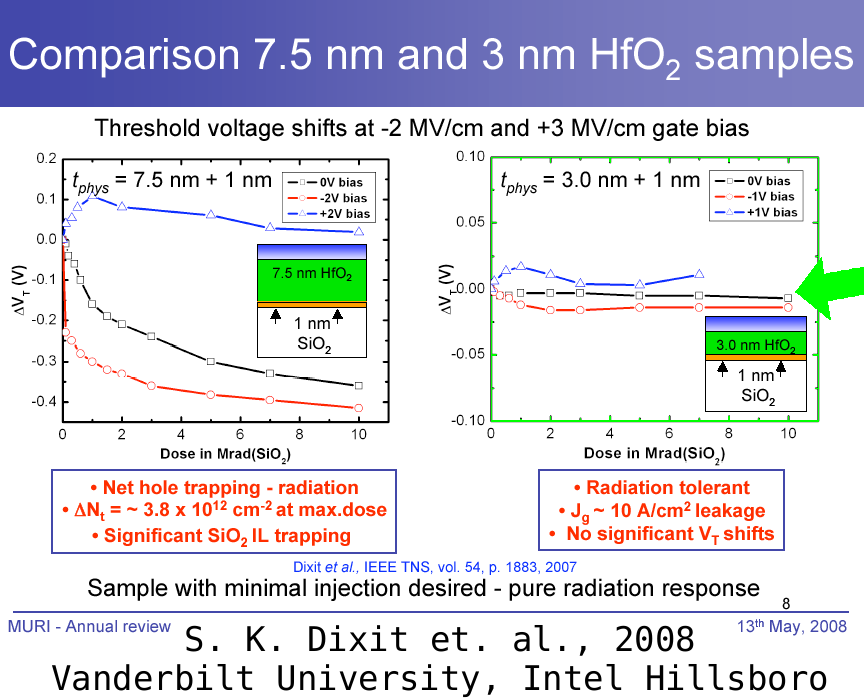
I wonder if that is tuned for Co60? Perhaps a wider spectrum of radiation energies, as would be found in the Van Allen belt, would preferentially charge either the !HfO or the SiO2, leaving a residual imbalance? In any case, it does demonstrate how modern gate oxides may be much more rad hard than older technologies.
Flash Memory Errors
Error correcting memory - MORE LATER
Crystal Lattice Damage
Annealing - MORE LATER
Space Junk and Debris
Server sky will be deployed in orbits higher than most space junk. The version 0.1 design deploys server-sats in m288 orbits, with semimajor axes of 12781 kilometers and average altitudes of 6411 kilometers. The vast majority of space debris is in lower orbits - it requires high launch velocities to even reach those altitudes.
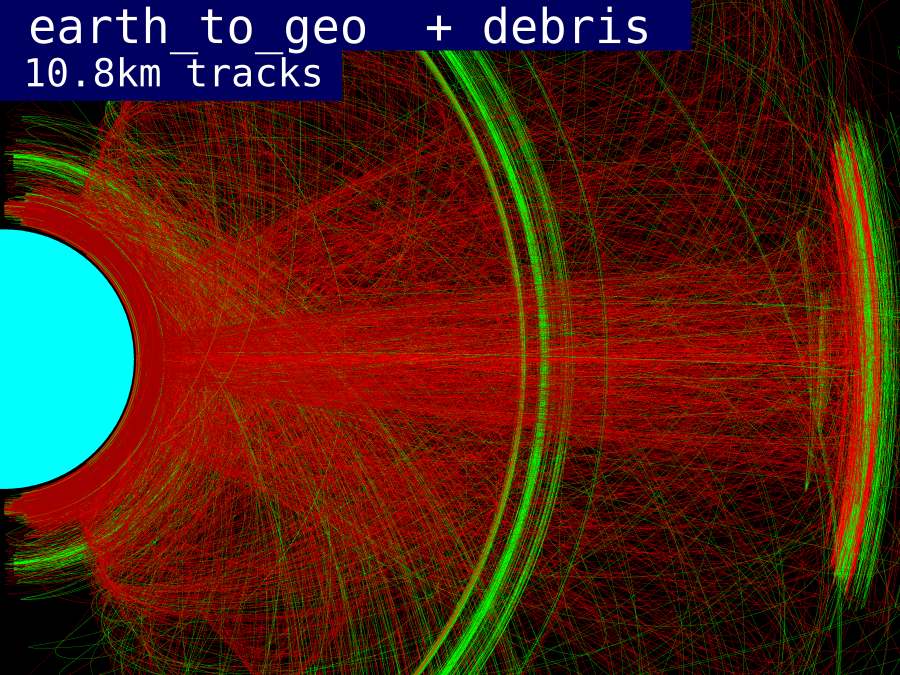
The above plot shows all the objects tracked by NORAD in orbits up to geosyncronous altitude. This is an "HV" plot, with the horizontal H component representing the radius in the equatorial plane, and the vertical V component representing the distance above the plane. All orbits will look like an ellipse or banana shape plotted in this way. Red is debris, darker red is spent rocket bodies, and green is useful satellites.
Th





Surface charging
Most of the area of a server-sat will be solar cells, with low voltages across the surface. If the LCD thrusters have glass covers with Indium oxide conductors on both sides, the outer conductors may be grounded relative to the rest of the server-sat. As all surfaces will be conductive, and at voltages less than one or two volts, there is no opportunity for arcing across surfaces, which sometimes happens to geosynchronous satellites in the solar wind ( see SMAD page 212-214 ).
MORE LATER
Night Side Temperature
When the server-sat orbit takes it to the night side of the earth, for about 1/6th of its orbit, it will only be heated by the thermal radiation from the earth, filling 0.5*(1 - cos(30deg)) or 6.7% of the sky with a black body temperature of 250K. At equilibrium, the temperature of the server-sat will be 250K times the fourth root of 0.067, or around 127K ( -146C ).
MORE LATER
Drag
MORE LATER
References
http://www.isde.vanderbilt.edu/content/muri_2008/dixit_muri2008.pdf Sriram Dixit et. al. at Vanderbilt University. Recent work on HfO/SiO2 stacked gates and radiation resistance.
http://apollo.cnuce.cnr.it/rossi/publications/iau/node2.html A 1994 estimate of space debris. There is more now, but it follows the same pattern.
